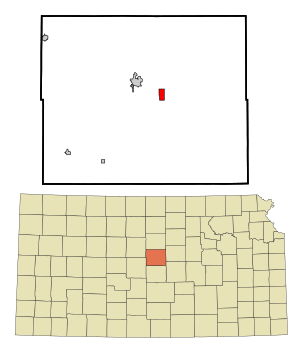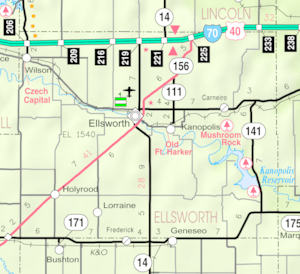Kanopolis, Kansas facts for kids
Quick facts for kids
Kanopolis, Kansas
|
|
|---|---|

|
|

|
|
| Country | United States |
| State | Kansas |
| County | Ellsworth |
| Founded | 1880s |
| Incorporated | 1887 |
| Government | |
| • Type | Mayor–Council |
| Area | |
| • Total | 1.18 sq mi (3.05 km2) |
| • Land | 1.18 sq mi (3.05 km2) |
| • Water | 0.00 sq mi (0.00 km2) |
| Elevation | 1,578 ft (481 m) |
| Population
(2020)
|
|
| • Total | 443 |
| • Density | 375.4/sq mi (145.2/km2) |
| Time zone | UTC-6 (CST) |
| • Summer (DST) | UTC-5 (CDT) |
| ZIP code |
67454
|
| Area code | 785 |
| FIPS code | 20-35950 |
| GNIS ID | 2395490 |
Kanopolis is a city in Ellsworth County, Kansas, United States. In 2020, the city had a population of 443 people. It was built where an old United States Army post, called Fort Harker, used to be. This fort housed soldiers who were involved in the Indian Wars from 1867 to 1872.
Contents
History of Kanopolis
Early History of Kansas
For thousands of years, the Great Plains of North America were home to nomadic Native American tribes. From the 16th to 18th centuries, France claimed large parts of North America. In 1762, France secretly gave New France to Spain after the French and Indian War.
In 1802, Spain returned most of this land to France. Then, in 1803, the United States bought most of the land that is now Kansas from France. This huge purchase was called the Louisiana Purchase. In 1854, the Kansas Territory was created. Kansas officially became the 34th U.S. state in 1861. In 1867, Ellsworth County was established, which included the land where Kanopolis is today.
Forts Before Kanopolis
The first military fort in the Kanopolis area was Fort Ellsworth. The United States Army built it in August 1864. It was located near the Smoky Hill River. Its main job was to protect the building of the Union Pacific railroad from Native American raids.
In November 1866, Fort Ellsworth was renamed Fort Harker. This was in honor of General G.H. Charles Harker, who died in battle. The fort became very important as a place to gather soldiers and supplies for other forts further west.
To handle its growing importance, the Army decided to build a new Fort Harker. This new fort was about three-quarters of a mile east of the old one. The original Fort Ellsworth closed in early 1867. The town of Ellsworth was then founded in its place.
In January 1867, the new Fort Harker was built on an open prairie. It was about one mile north of the Smoky Hill River. This new location had a large, well-equipped hospital. Sadly, about 200 people died from cholera in and around Fort Harker in 1867. For the next five years, Fort Harker was one of the most important military stations west of the Missouri River. It had 700 soldiers and many civilian workers. It also supplied mail to many other military posts.
Over time, the danger from Native American raids decreased as the railroad moved west. Fort Harker was no longer needed in its location. It was closed on April 2, 1872. Its soldiers moved to Fort Hays. The land around the fort became the "Fort Harker Military Reservation."
How Kanopolis Started
In June 1880, the government decided to sell the Fort Harker Military Reservation land. This was a large area of 10,240 acres. A Dr. Hodge bought the land and then sold it to Col. Henry Johnson in August 1881.
In the summer of 1885, a group of seventeen business people from Ohio bought 4,740 acres of this land from Col. Johnson. This included Fort Harker and its buildings. They paid $71,000 for it. This group believed their new land would become a "Central Metropolis" and even a future capital city.
On March 15, 1886, they formed the Kanopolis Land Company. They planned out land for 150,000 people. Soon after, the town of Kanopolis was founded.
Big Hopes for Kanopolis
The Kanopolis Land Company wanted to attract many people to their new town. They advertised in newspapers, including their own paper called The Kanopolis Journal. These advertisements were examples of "boosterism." This was a common way to promote new towns in the American West.
One advertisement from May 1886 said Kanopolis would become the "railroad, commercial, and manufacturing capital of Kansas." It also claimed that buying land in Kanopolis was the "Best investment in the world." Another ad in July 1887 said Kanopolis was the only town in Kansas with railroads going in all four directions. It also claimed the town had seven factories, thirteen stores, and a hotel. It reported a population of 600 when the town was barely a year old.
The Kanopolis Journal made even bigger claims. It said Kanopolis had "woolen mills, iron factories, carriage works, flour mills, wholesale houses, banks, a drug store, and an opera house." It even predicted that Kanopolis would soon be the furniture center of the Midwest. The journal also made funny, exaggerated claims about giant potatoes and cabbage leaves as big as circus tents! It even joked that the area around Kanopolis was the real Garden of Eden.
Why Kanopolis Didn't Grow as Expected
Kanopolis never became the huge "Queen City of the Midwest" that its founders hoped for. One big reason was that it lost a vote by only 75 votes to become the main city of Ellsworth County.
Also, some people didn't believe in Kanopolis. An article in a January 1887 newspaper called Kanopolis a "fraud" and a "scheme." By 1906, the population of Kanopolis had dropped to 264 people.
Geography
Kanopolis covers an area of about 1.20 square miles (3.05 square kilometers). All of this area is land.
Climate in Kanopolis
The weather in Kanopolis has hot, humid summers. Winters are usually mild to cool. According to the Köppen Climate Classification system, Kanopolis has a humid subtropical climate. This type of climate is often shown as "Cfa" on climate maps.
Population Information
| Historical population | |||
|---|---|---|---|
| Census | Pop. | %± | |
| 1890 | 272 | — | |
| 1900 | 240 | −11.8% | |
| 1910 | 577 | 140.4% | |
| 1920 | 762 | 32.1% | |
| 1930 | 860 | 12.9% | |
| 1940 | 868 | 0.9% | |
| 1950 | 743 | −14.4% | |
| 1960 | 732 | −1.5% | |
| 1970 | 626 | −14.5% | |
| 1980 | 729 | 16.5% | |
| 1990 | 605 | −17.0% | |
| 2000 | 543 | −10.2% | |
| 2010 | 492 | −9.4% | |
| 2020 | 443 | −10.0% | |
| U.S. Decennial Census | |||
2020 Population Count
The 2020 United States census counted 443 people living in Kanopolis. There were 205 households and 111 families. The population density was about 376 people per square mile. Most of the people (92.1%) were white. About 9% of the population was Hispanic or Latino.
About 20% of households had children under 18. Many households (42.9%) were married couples. About 42% of households were individuals living alone. The average household had 1.9 people. The average family had 2.5 people.
The median age in the city was 47.9 years. About 24% of the population was under 18. About 26% was between 45 and 64 years old. And about 25% was 65 years or older.
2010 Population Count
In the census of 2010, there were 492 people living in Kanopolis. There were 235 households and 151 families. The population density was about 410 people per square mile. Most people (94.5%) were White. About 10.4% of the population was Hispanic or Latino.
About 20% of households had children under 18. Many households (50.6%) were married couples living together. About 34% of all households were made up of individuals. And about 15% had someone living alone who was 65 or older. The average household size was 2.09 people. The average family size was 2.58 people.
The median age in the city was 48.7 years. About 16.7% of residents were under 18. About 20.7% were 65 years or older.
Economy
The Independent Salt Company is located about a mile northeast of Kanopolis.
Education
The public schools in Kanopolis are part of the Ellsworth USD 327 school district. The district's high school is in Ellsworth. The Ellsworth High School sports teams are called the Ellsworth Bearcats.
Kanopolis used to have its own high school, but it closed when schools combined. The Kanopolis High School mascot was the Kanopolis Bulldogs.
Parks and Recreation
- Kanopolis Lake and Kanopolis State Park
- Mushroom Rock State Park
- Faris Caves
- Kanopolis Drive-in Theatre
See also
 In Spanish: Kanopolis (Kansas) para niños
In Spanish: Kanopolis (Kansas) para niños


